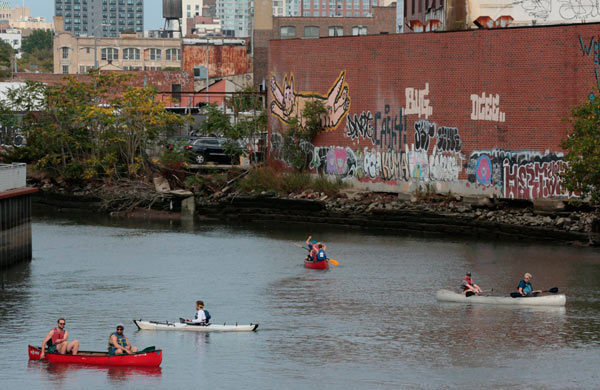They’re schooling fishers!
New signs warning anglers about the dangers of eating marine life caught in the fetid Gowanus Canal will soon line the toxic waterway after members of a neighborhood-advisory group asked the Feds overseeing its cleanup to put up a dozen placards in English and Spanish at prime casting spots.
“We ask that such warnings be placed in reasonably likely fishing locations and at each public-access location where people can easily make physical contact with the canal,” locals in the Gowanus Community Advisory Group wrote in a letter to the Environmental Protection Agency bigwig in charge of the ongoing cleanse.
The state’s Departments of Health and Environmental Conservation typically handle hanging regulations related to fish consumption along bodies of water. But because the canal filled with noxious sludge, tampons, poop, and dead cats — as well as with apparently edible creatures of the deep — is a federal Superfund site, protection agency leaders can fast-track the production of the warnings, according to the scrub’s steward.
“It is a Superfund site, so the EPA has jurisdiction to produce signs, which is an easier process than going through state agencies,” said Christos Tsiamis.
Federal and state officials worked together to create a draft placard that is now being reviewed by the neighborhood group, according to Tsiamis, who discussed the request at a March 27 meeting with the locals and said it is ultimately up to his agency and the state to decide how many signs go up and where to hang them, and that those who polluted Brooklyn’s Nautical Purgatory — including the city and utility company National Grid — must foot the bill for the warnings.
“The state prepared a format, it is the expert on the health issues — so once we get the CAG’s input then I will ask the parties responsible for the contamination,” he said.
Line casters who dare drop hooks into the canal’s murky abyss must first obtain a $25 permit from the state and sign up with its recreational-marine-fishing registry if they are 16 or older, but aspiring anglers 15-years-old or younger can fish for free without registering, according to information from the Environmental Conservation Department.
And now that the cleanup is underway, members of the neighborhood group demanded signs in both languages featuring universally understood graphics in order to inform more people of potential fishing hazards after the city plastered less specific warnings near the waterway’s sewer outfalls — which release excess storm water and sewage into the canal during heavy rainfall — and by the popular fishing spot at the nearby Columbia Street pier in Red Hook.
“As dredging begins, there’s a strong sense that there should be enough so that people are aware,” said Community Advisory Group member Marlene Donnelly.
The new placards will list about 15 fish and shellfish including the American eel, gizzard shad, striped bass, and blue crab that allegedly are found in Brooklyn’s Nautical Purgatory — where other sea creatures including the young Minke whale “Sludgie” and a dolphin met their early ends after getting trapped in the channel — and warn locals that anything caught in its toxic waters could contain chemicals that are dangerous to eat, particularly for women and children, according to drafts obtained by the Brooklyn Paper.
One warning, for instance, cautions that men older than 15 and women older than 50 can safely munch on up to six blue crabs per week, but that ladies younger than 50 — especially those bearing child — and kids younger than 15 should not risk taking a single bite.
But the draft signs curiously do not address the health risks of consuming three-eyed fish such as the specimen one angler claimed to hook in the Gowanus Canal in 2015.
And elsewhere on Brooklyn’s Nautical Purgatory, the slow-going dredging-and-capping pilot program that got stuck in the mud in January due to equipment-related setbacks kicked off on March 22, according to Tsiamis, who said he expects the process of removing chemical-filled sediment from a portion of the canal’s floor before covering it with a protective layer to wrap sometime in June.

























